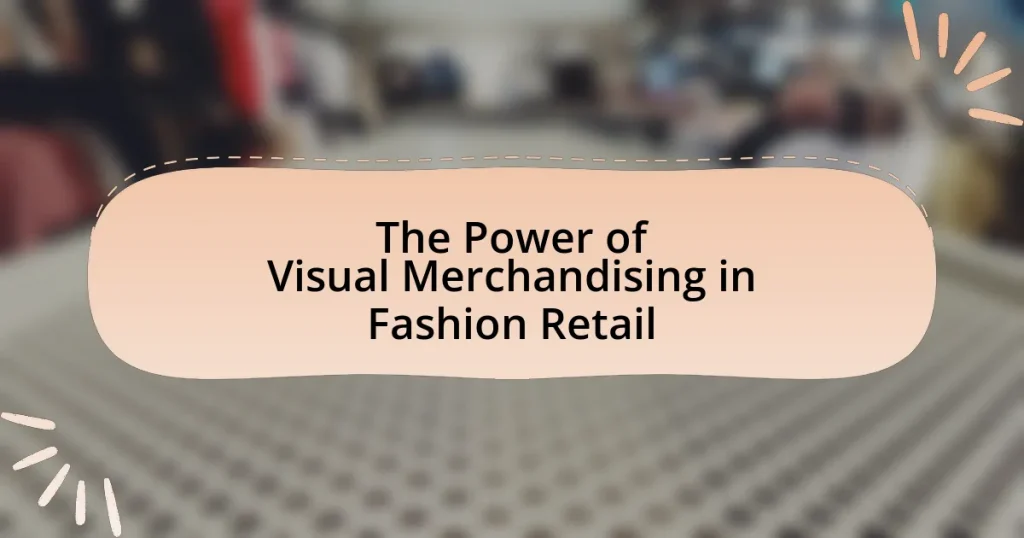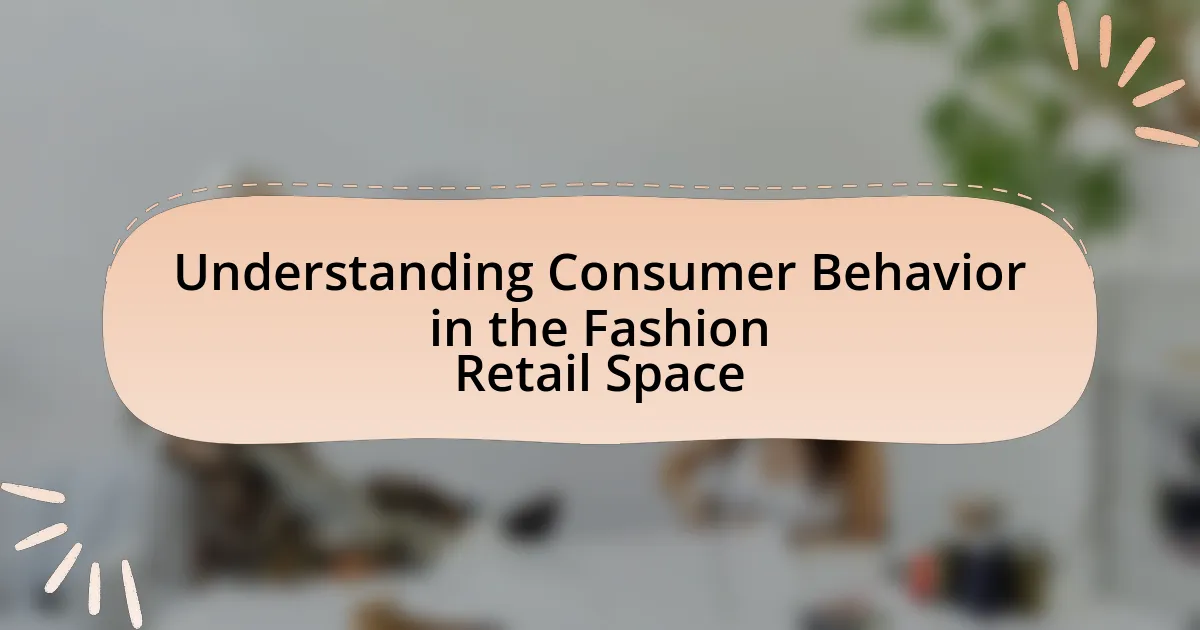The article examines the significant role of visual merchandising in fashion retail, highlighting its impact on customer engagement and sales. It discusses how effective visual merchandising strategies, including the use of color, layout, lighting, and signage, can enhance the shopping experience and influence consumer behavior, leading to increased sales by up to 30%. The article also explores psychological principles at play, the importance of brand identity, and the key elements of visual merchandising, such as store layout and product placement. Additionally, it addresses best practices for retailers to optimize their visual merchandising efforts and the metrics to measure their effectiveness.
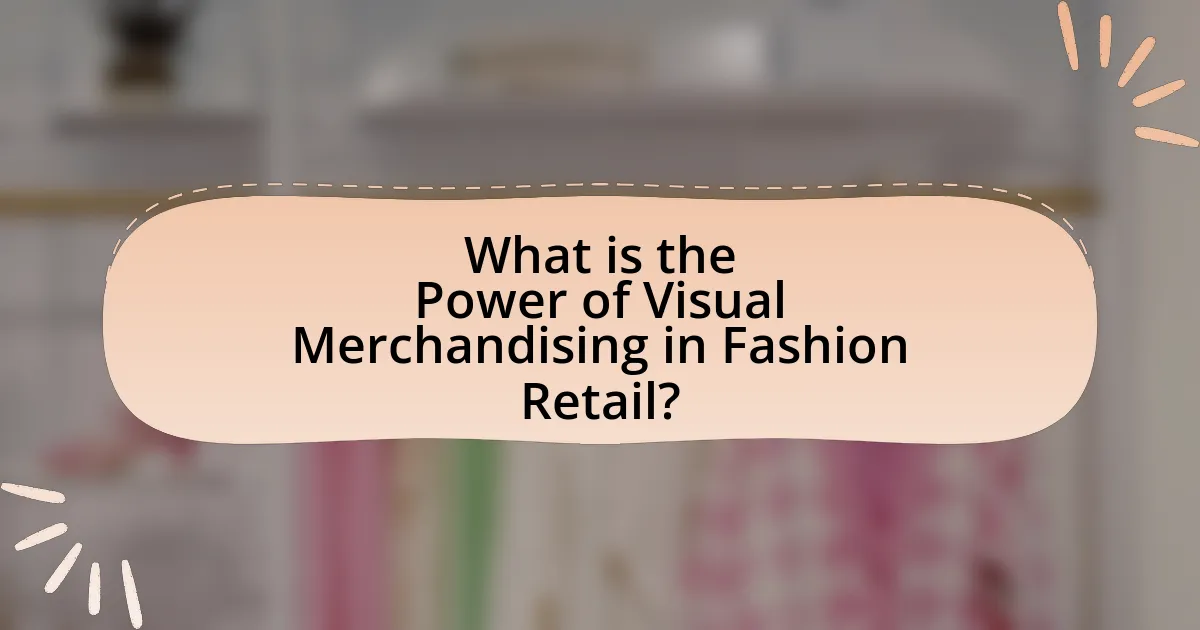
What is the Power of Visual Merchandising in Fashion Retail?
The power of visual merchandising in fashion retail lies in its ability to enhance customer engagement and drive sales through strategic presentation of products. Effective visual merchandising utilizes elements such as color, layout, lighting, and signage to create an appealing shopping environment that attracts customers and encourages them to make purchases. Research indicates that well-executed visual merchandising can increase sales by up to 20%, as it influences consumer behavior and enhances brand perception. For instance, a study by the Journal of Retailing found that visual displays significantly impact customers’ emotional responses, leading to increased time spent in stores and higher likelihood of purchase.
How does visual merchandising influence consumer behavior?
Visual merchandising significantly influences consumer behavior by enhancing the shopping experience and driving purchase decisions. Effective visual merchandising strategies, such as product placement, color schemes, and lighting, create an inviting atmosphere that captures consumer attention and encourages exploration. Research indicates that 70% of purchasing decisions are made in-store, highlighting the impact of visual elements on consumer choices. Additionally, studies show that well-designed displays can increase sales by up to 30%, demonstrating the direct correlation between visual merchandising and consumer spending.
What psychological principles are at play in visual merchandising?
Visual merchandising employs several psychological principles, including the principles of perception, color psychology, and the scarcity effect. Perception influences how customers interpret visual stimuli, guiding their attention to specific products through strategic placement and arrangement. Color psychology affects emotions and behaviors; for instance, warm colors can evoke excitement, while cool colors may induce calmness, impacting purchasing decisions. The scarcity effect creates urgency, as limited availability can increase desirability, prompting consumers to act quickly. These principles are validated by studies showing that effective visual merchandising can significantly enhance customer engagement and sales performance in retail environments.
How do colors and lighting affect shopping experiences?
Colors and lighting significantly influence shopping experiences by affecting customer emotions and perceptions. Research indicates that colors can evoke specific feelings; for example, blue often creates a sense of trust, while red can stimulate excitement and urgency. A study published in the Journal of Retailing found that warm lighting enhances the perception of product quality and encourages longer shopping durations. Additionally, effective lighting can highlight products, making them more appealing and increasing the likelihood of purchase. Therefore, the strategic use of colors and lighting in retail environments can enhance customer engagement and drive sales.
Why is visual merchandising essential for fashion retailers?
Visual merchandising is essential for fashion retailers because it significantly influences consumer behavior and enhances the shopping experience. Effective visual merchandising attracts customers, communicates brand identity, and showcases products in a way that encourages purchases. Research indicates that well-executed visual displays can increase sales by up to 30%, demonstrating its impact on retail performance. Additionally, visual merchandising helps differentiate a brand in a competitive market, making it crucial for fashion retailers aiming to capture consumer attention and drive sales.
What role does visual merchandising play in brand identity?
Visual merchandising plays a crucial role in establishing and communicating brand identity by creating a cohesive visual experience that reflects the brand’s values and aesthetics. This practice involves the strategic arrangement of products, colors, and displays to evoke specific emotions and perceptions associated with the brand. For instance, luxury brands often utilize minimalist designs and high-quality materials in their visual merchandising to convey exclusivity and sophistication, which reinforces their brand identity. Research indicates that effective visual merchandising can increase sales by up to 20%, demonstrating its impact on consumer behavior and brand recognition.
How can effective visual merchandising increase sales?
Effective visual merchandising can increase sales by enhancing product visibility and creating an engaging shopping experience. When products are displayed attractively, they capture customer attention and encourage impulse purchases. Research indicates that well-executed visual merchandising can lead to a 20% increase in sales, as it influences consumer behavior by appealing to emotions and aesthetics. For instance, a study by the Journal of Retailing found that stores with effective visual displays saw a significant rise in foot traffic and conversion rates, demonstrating the direct correlation between visual merchandising strategies and sales performance.
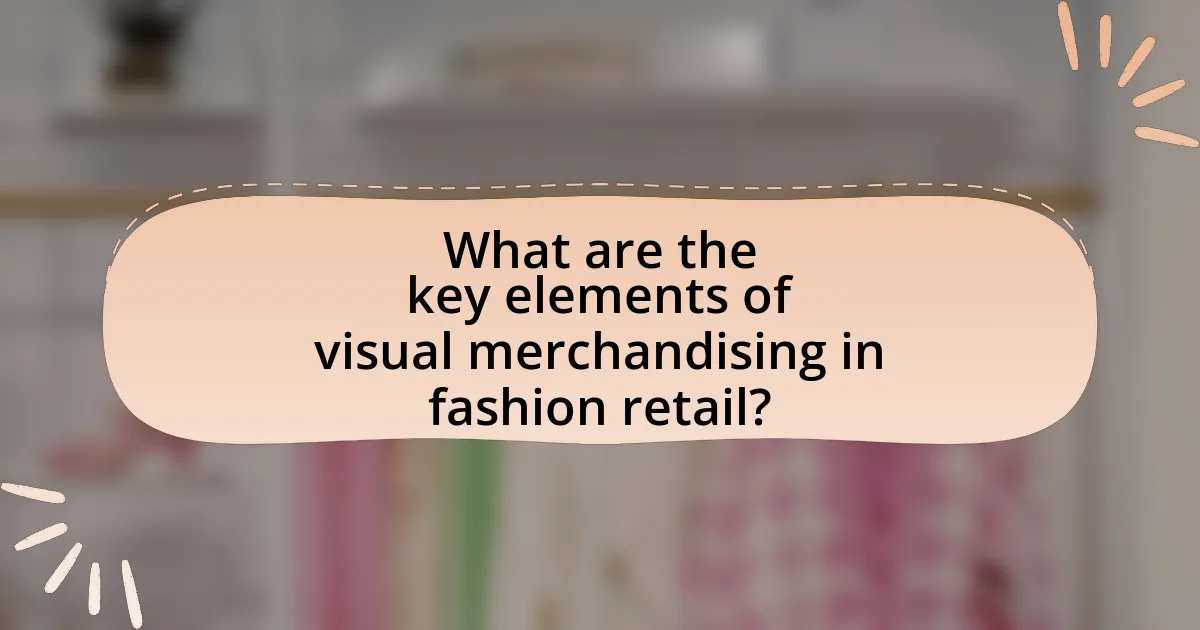
What are the key elements of visual merchandising in fashion retail?
The key elements of visual merchandising in fashion retail include store layout, product presentation, signage, lighting, and color schemes. Store layout influences customer flow and accessibility, while product presentation involves arranging items to highlight their features and encourage purchases. Signage provides essential information and branding, enhancing the shopping experience. Lighting plays a crucial role in creating ambiance and drawing attention to specific products, and color schemes can evoke emotions and influence consumer behavior. Together, these elements create an engaging environment that can significantly impact sales and customer satisfaction.
How do store layout and design impact visual merchandising?
Store layout and design significantly impact visual merchandising by influencing customer flow and product visibility. An effective layout directs shoppers through the store, encouraging them to engage with displays and products, which can increase sales. For instance, a study by the Journal of Retailing found that stores with well-defined pathways and strategically placed focal points can enhance customer dwell time by up to 30%. Additionally, design elements such as lighting, color schemes, and signage can create an inviting atmosphere that enhances the shopping experience, making products more appealing. Therefore, the interplay between layout and design is crucial for optimizing visual merchandising strategies in fashion retail.
What are the different types of store layouts used in fashion retail?
The different types of store layouts used in fashion retail include grid layout, racetrack layout, free-flow layout, and boutique layout. The grid layout features long aisles and is efficient for maximizing space, commonly used in discount stores. The racetrack layout creates a circular path, encouraging customers to explore the entire store, often seen in department stores. The free-flow layout allows for a more relaxed shopping experience, promoting creativity and exploration, typical in specialty boutiques. Lastly, the boutique layout focuses on creating an intimate shopping environment, emphasizing unique displays and personalized service. Each layout type is strategically designed to enhance customer experience and drive sales in fashion retail.
How does product placement enhance visual appeal?
Product placement enhances visual appeal by seamlessly integrating branded products into visual narratives, making them more relatable and engaging for the audience. This technique captures attention and creates a sense of authenticity, as viewers often perceive these products as part of a lifestyle rather than mere advertisements. Research indicates that product placement can increase brand recall by up to 20%, demonstrating its effectiveness in enhancing visual storytelling and consumer connection.
What techniques are commonly used in visual merchandising?
Common techniques used in visual merchandising include color blocking, strategic product placement, and thematic displays. Color blocking involves using contrasting colors to attract attention and create visual interest, which can enhance customer engagement. Strategic product placement focuses on positioning items in a way that encourages purchases, often placing high-demand products at eye level or near checkout areas. Thematic displays create a cohesive story or concept that resonates with customers, often aligning with seasonal trends or brand identity, which can significantly influence consumer behavior and increase sales.
How do mannequins and displays attract customer attention?
Mannequins and displays attract customer attention by creating visually appealing presentations that highlight products effectively. These visual merchandising tools utilize strategic positioning, color contrast, and thematic storytelling to draw the eye of potential buyers. Research indicates that well-designed displays can increase sales by up to 30%, as they engage customers and encourage them to explore the merchandise further. Additionally, mannequins that reflect current fashion trends and styles resonate with consumers, making them more likely to connect emotionally with the displayed items.
What is the significance of signage and graphics in stores?
Signage and graphics in stores are crucial for guiding customer behavior and enhancing the shopping experience. They serve to communicate brand identity, convey promotional messages, and provide essential information about products and store layout. Research indicates that effective signage can increase sales by up to 20%, as it helps customers navigate the store and make informed purchasing decisions. Additionally, well-designed graphics can create an emotional connection with consumers, reinforcing brand loyalty and encouraging repeat visits.
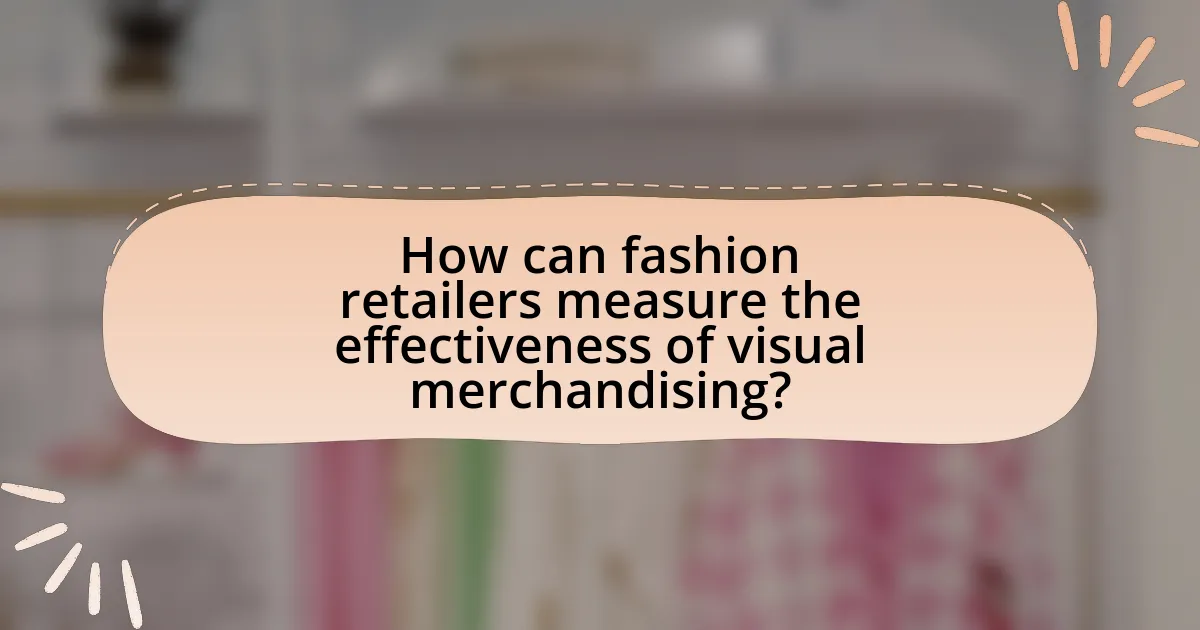
How can fashion retailers measure the effectiveness of visual merchandising?
Fashion retailers can measure the effectiveness of visual merchandising through sales data analysis, customer feedback, and foot traffic metrics. By analyzing sales data before and after visual merchandising changes, retailers can identify correlations between specific displays and sales performance. Customer feedback, collected through surveys or direct interactions, provides insights into consumer perceptions and preferences regarding visual displays. Additionally, foot traffic metrics, often tracked using in-store analytics tools, help retailers understand how many customers engage with specific displays, indicating their effectiveness in attracting attention. These methods collectively provide a comprehensive view of visual merchandising impact on retail performance.
What metrics should retailers track to assess visual merchandising success?
Retailers should track sales per square foot, conversion rates, and customer engagement metrics to assess visual merchandising success. Sales per square foot indicates how effectively the retail space is utilized, reflecting the impact of visual displays on purchasing behavior. Conversion rates measure the percentage of visitors who make a purchase, providing insight into how well visual merchandising attracts and persuades customers. Customer engagement metrics, such as time spent in-store and interaction with displays, reveal how compelling the visual elements are in capturing consumer interest. These metrics collectively provide a comprehensive view of the effectiveness of visual merchandising strategies in driving sales and enhancing customer experience.
How can customer feedback inform visual merchandising strategies?
Customer feedback can significantly inform visual merchandising strategies by providing insights into customer preferences and behaviors. Retailers can analyze feedback to identify which displays attract attention, which products are favored, and how customers interact with the store layout. For instance, a study by the Journal of Retailing found that 70% of consumers are influenced by visual merchandising when making a purchase decision. By incorporating this feedback, retailers can optimize product placement, enhance store aesthetics, and create a more engaging shopping experience that aligns with customer expectations.
What role does sales data play in evaluating visual merchandising impact?
Sales data is crucial in evaluating the impact of visual merchandising as it provides measurable insights into consumer behavior and purchasing patterns. By analyzing sales data before and after visual merchandising changes, retailers can determine the effectiveness of specific displays, layouts, and promotional strategies. For instance, a study by the Journal of Retailing found that stores that implemented strategic visual merchandising saw a 20% increase in sales compared to those that did not. This correlation between sales performance and visual merchandising efforts allows retailers to make data-driven decisions, optimizing their displays to enhance customer engagement and drive revenue.
What best practices can enhance visual merchandising efforts?
Effective visual merchandising can be enhanced through strategic product placement, cohesive color schemes, and engaging displays. Strategic product placement involves positioning items at eye level and grouping complementary products to encourage cross-selling, which can increase sales by up to 30% according to retail studies. Cohesive color schemes attract attention and create a harmonious shopping experience, as colors can influence consumer emotions and purchasing decisions. Engaging displays, such as interactive elements or seasonal themes, can draw customers in and enhance their shopping experience, leading to longer store visits and increased sales. These best practices are supported by research indicating that well-executed visual merchandising can significantly impact consumer behavior and drive retail success.
How can retailers stay updated with visual merchandising trends?
Retailers can stay updated with visual merchandising trends by actively engaging with industry publications, attending trade shows, and leveraging social media platforms. Industry publications such as Retail Dive and Visual Merchandising and Store Design provide insights into the latest trends and best practices. Trade shows like EuroShop and GlobalShop showcase innovative merchandising techniques and technologies. Additionally, social media platforms, particularly Instagram and Pinterest, serve as valuable resources for visual inspiration and trend spotting, as they highlight real-time consumer preferences and successful merchandising examples from competitors. This multi-faceted approach ensures that retailers remain informed and can adapt their strategies to align with current visual merchandising trends.
What are some common mistakes to avoid in visual merchandising?
Common mistakes to avoid in visual merchandising include overcrowding displays, neglecting lighting, and failing to tell a cohesive story. Overcrowding can overwhelm customers, making it difficult for them to focus on individual products, which can lead to decreased sales. Neglecting lighting can diminish the appeal of products; studies show that well-lit displays can increase customer engagement by up to 30%. Lastly, failing to create a cohesive narrative can confuse customers, as a clear theme helps guide their shopping experience and enhances brand identity.
